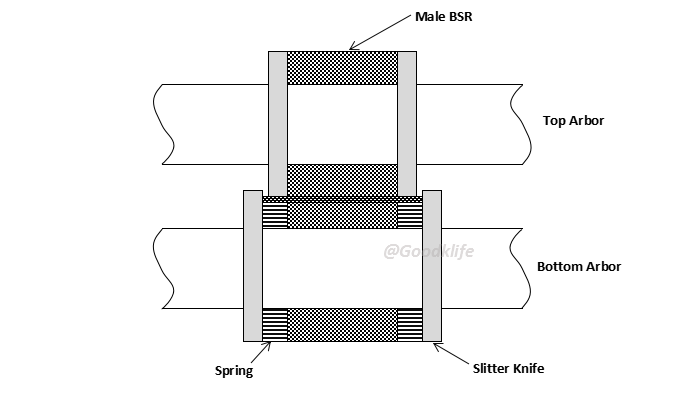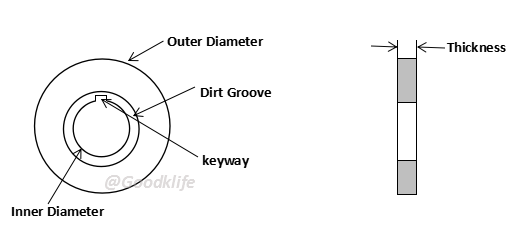The working principle of the slitting machine and the schematic diagram of the slitting knife setup
Views : 14271
Author : Mr. Jiang
Update time : 2021-06-04 21:02:25
1. The principle of slitting processing
The schematic diagram of the slitting process is shown in the figure below:
The schematic diagram of the slitting process is shown in the figure below:

The raw materials are unrolled by uncoiling and sent to the slitter head to be cut into strips, and then rewinded into a roll by a winder.

In the slitting industry, the choices of knife, spacer, the horizontal clearance of the knife and the overlap of the knife are all important, which are related to the precision and quality of the finished product.
2. The choice of knife

Slitter Knife with (without) Keyway & Dirt Groove
1). Material selection
In the slitting machine cutting industry, the role of metal elements in the blade material is as follows:
In the slitting machine cutting industry, the role of metal elements in the blade material is as follows:
A. Cr-containing metal products can make the metal structure finer and have the function of preventing rust.
B. Mo-containing metal products can increase the strength and hardness of the metal, making it have higher cutting performance.
C. Vanadium-containing metals have a great effect on impact resistance and fatigue.
D. When the carbon content is high, the section can be made finer, but its toughness is reduced, which can increase its wear resistance.
E. Silicon (Si) can make the internal organization of the knife closer, but it will increase its brittleness.
F. Manganese has the function of deacidification and oxygen reduction, and can prevent rust and corrosion. The content of manganese can increase its toughness within a certain range.
G. Phosphorus (P) and nitrogen (N) can increase the corrosion resistance of steel products, but it’s brittleness will increase.
H. Nickel (Ni) can reduce the coefficient of thermal expansion of the knife, reduce magnetic permeability, and reduce high-temperature rusting.
I. Tungsten (W) can increase the quenching temperature to obtain the best hardness.
D. When the carbon content is high, the section can be made finer, but its toughness is reduced, which can increase its wear resistance.
E. Silicon (Si) can make the internal organization of the knife closer, but it will increase its brittleness.
F. Manganese has the function of deacidification and oxygen reduction, and can prevent rust and corrosion. The content of manganese can increase its toughness within a certain range.
G. Phosphorus (P) and nitrogen (N) can increase the corrosion resistance of steel products, but it’s brittleness will increase.
H. Nickel (Ni) can reduce the coefficient of thermal expansion of the knife, reduce magnetic permeability, and reduce high-temperature rusting.
I. Tungsten (W) can increase the quenching temperature to obtain the best hardness.
Due to the anti-shearing and abrasion between the knife and the plate, the knife will generate surface fatigue layer, and the suitable material of the knife can prolong its service life as much as possible. At present, the common blade materials are:
A. G6 (SKD-11) (high hardness cold die alloy steel), G5
B. G24, G25, etc. (molybdenum series high-speed tool steel)
C. G4, G8, etc. (low hardness cold die alloy steel)
Analysis of metal elements of the knife material and relative application:
A. G6 (SKD-11): its carbon content is between 1.4 and 1.6, and the chromium content is between 11.00 and 13.00. Compared with other alloys, the content of Mo and V has higher hardness (it can reach Hardness range 58°-60°), toughness and wear resistance, suitable for the following applications:
① Cold rolled plate (SPCC) 0.3 ~ 3.2;
②Surface treatment board (electrolysis, galvanization, color, etc.) 0.3 ~ 3.2;
③Stainless steel (SUS) 0.1~1.0.
B. G4: With high nickel content and high toughness, it is suitable for shearing thick hot-rolled plates and high-tension plates, but has poor wear resistance.
C. G8: It is between G4 and G8, suitable for mid-slab cutting.
D. G24: High content of tungsten, molybdenum, and vanadium. It is the same series of molybdenum high-speed tool steel (SKH-9) with SKH-54 and has high wear resistance. HRC60°~63°
E. G25: It is a higher grade material of SKH-9 series, HRC61°~64°.
① Cold rolled plate (SPCC) 0.3 ~ 3.2;
②Surface treatment board (electrolysis, galvanization, color, etc.) 0.3 ~ 3.2;
③Stainless steel (SUS) 0.1~1.0.
B. G4: With high nickel content and high toughness, it is suitable for shearing thick hot-rolled plates and high-tension plates, but has poor wear resistance.
C. G8: It is between G4 and G8, suitable for mid-slab cutting.
D. G24: High content of tungsten, molybdenum, and vanadium. It is the same series of molybdenum high-speed tool steel (SKH-9) with SKH-54 and has high wear resistance. HRC60°~63°
E. G25: It is a higher grade material of SKH-9 series, HRC61°~64°.
2). Selection of thickness and size: Make a suitable choice according to the thickness and hardness of the material to be cut, generally according to the following rules (for reference only):
A. Thickness: more than 3 times the thickness of the shear plate.
B. Outer diameter: more than 40 times the thickness of the shear plate.
C. Knife extension: 25 times or less of the plate thickness;
D. For knives with keyway, the keyway must have an R angle.
B. Outer diameter: more than 40 times the thickness of the shear plate.
C. Knife extension: 25 times or less of the plate thickness;
D. For knives with keyway, the keyway must have an R angle.
3). Precision requirements: It depends on the thinnest sheet and the precision requirements of the finished product. According to the requirements of conventional slitter knives: flatness within 0.003 mm, thickness within ± 0.003 mm, and concentricity within 0.01 mm. The accuracy of the spacer is the same as that of the knife.
3. Slitter knife setup
1). According to the current knife setup methods, slitting tools combinations are usually divided into two categories:
A. Down-cutting combination: it is called "male", and its combination method depends on the slitting specifications, plate specification, and thickness. If expressed in formula, it is: male unit = slitting specification (female unit) -knife thickness × 2-single horizontal clearance × 2.
B. Slitting specification combination: it is called "female" or inside cutting combination. The combination method is determined by the width of the required strip. If the required strip width for slitting is 80, the combined length is 80.
For example: a normal plate with a strip width of 80 and a plate thickness of 1.0, the knife thickness is 10, the horizontal clearance is 0.1, and the female unit= 80 mm, male unit = 80-10×2-0.1×2 = 59.8 mm.
B. Slitting specification combination: it is called "female" or inside cutting combination. The combination method is determined by the width of the required strip. If the required strip width for slitting is 80, the combined length is 80.
For example: a normal plate with a strip width of 80 and a plate thickness of 1.0, the knife thickness is 10, the horizontal clearance is 0.1, and the female unit= 80 mm, male unit = 80-10×2-0.1×2 = 59.8 mm.
2). The above is the knife setup method. In the slitting operation, how to smoothly push the finished product out of the cutting area requires a corresponding device. There are: A. bonded stripper ring B, wood finger, etc.
A. Bonded stripper ring:
①The bonded stripper ring we use usually adopts oil-resistant and wear-resistant rubber, such as polyurethane, also known as urethane rubber, and its chemical name symbol is "PU". Another commonly used rubber is nitrile rubber. These materials have high oil resistance, wear resistance, corrosion resistance and better deformation recovery ability. According to the different shear materials, we will make the corresponding hardness adjustment treatment according to the thickness and specification of the shear plate when manufacturing this accessory. Generally The hardness range is HS 60~90°.
②Selection of bonded stripper ring size: The size of the bonded stripper ring is usually determined by the size of the knife and the size of the spacer. When cutting different thickness plates, use the corresponding outer diameter of the bonded stripper ring to ensure the appearance of the finished product is smooth and the surface quality. However, considering the diversity of sheet thickness, when we decide the outer diameter of the bonded stripper ring, we usually choose two kinds of bonded stripper ring with the different outer diameters: the rubber with the same outer diameter of the knife and 1~2mm larger than the outer diameter of the knife. When manufacturing bonded stripper rings, considering their different sizes, we can distinguish them by different colors, such as: choose red as big as the knife, choose black for bonded stripper rings slightly larger than the knife, etc. Because of the different cutting specifications, its thickness tends to be a universal combination. According to the above statement, some people may ask whether the bonded stripper rings with two outer diameters can meet the use of all thickness plates? Theoretically, it is not workable. But some clients use position spring to solve this problem.
③Bonded stripper ring setup method: usually the "female" knife is equipped with a smaller bonded stripper ring, and the "male" knife is equipped with a relatively large bonded stripper ring, so as to ensure that the strip can be pushed out smoothly. The strip has no knife indentation and embossing, the method is as follows:
①The bonded stripper ring we use usually adopts oil-resistant and wear-resistant rubber, such as polyurethane, also known as urethane rubber, and its chemical name symbol is "PU". Another commonly used rubber is nitrile rubber. These materials have high oil resistance, wear resistance, corrosion resistance and better deformation recovery ability. According to the different shear materials, we will make the corresponding hardness adjustment treatment according to the thickness and specification of the shear plate when manufacturing this accessory. Generally The hardness range is HS 60~90°.
②Selection of bonded stripper ring size: The size of the bonded stripper ring is usually determined by the size of the knife and the size of the spacer. When cutting different thickness plates, use the corresponding outer diameter of the bonded stripper ring to ensure the appearance of the finished product is smooth and the surface quality. However, considering the diversity of sheet thickness, when we decide the outer diameter of the bonded stripper ring, we usually choose two kinds of bonded stripper ring with the different outer diameters: the rubber with the same outer diameter of the knife and 1~2mm larger than the outer diameter of the knife. When manufacturing bonded stripper rings, considering their different sizes, we can distinguish them by different colors, such as: choose red as big as the knife, choose black for bonded stripper rings slightly larger than the knife, etc. Because of the different cutting specifications, its thickness tends to be a universal combination. According to the above statement, some people may ask whether the bonded stripper rings with two outer diameters can meet the use of all thickness plates? Theoretically, it is not workable. But some clients use position spring to solve this problem.
③Bonded stripper ring setup method: usually the "female" knife is equipped with a smaller bonded stripper ring, and the "male" knife is equipped with a relatively large bonded stripper ring, so as to ensure that the strip can be pushed out smoothly. The strip has no knife indentation and embossing, the method is as follows:

Bonded Stripper Rings Setup Diagram
B. Wood finger:
The wood stripper boards we usually choose are hard bakelite (phenolic resin board), red mixed solid wood, etc., with anti-scratch materials attached to the surface. The wood stripper boards is mainly suitable for thin plates with multiple specifications and small specifications. For the slitting of finished products with poor plate shape, the arrangement method is basically the same as that of the bonded stripper ring, but the slitting line must be supplemented with the wood stripper boards support device.
The wood stripper boards we usually choose are hard bakelite (phenolic resin board), red mixed solid wood, etc., with anti-scratch materials attached to the surface. The wood stripper boards is mainly suitable for thin plates with multiple specifications and small specifications. For the slitting of finished products with poor plate shape, the arrangement method is basically the same as that of the bonded stripper ring, but the slitting line must be supplemented with the wood stripper boards support device.
3). The amount of horizontal clearance and knife overlap
A. The knife horizontal clearance must be determined by the thickness and specification of the plate, and its value shall be between 6% and 12% of the thickness of the plate according to the conventional method:
Normal material: such as SPCC, SPHC, SECC, the clearance parameter is 8%~10%;
Stainless steel: SUS clearance parameter is 7%~11%;
Silicon steel sheet: SI clearance parameter is 7%~11%;
High carbon steel: 65Mn, S20C and other clearance parameters are 8%~12%;
Non-ferrous metals: clearance parameters such as AL, Cn, Zn are 5%~10%.
The above parameters are for reference only, and make appropriate adjustments according to the actual situation in the actual operation.
Normal material: such as SPCC, SPHC, SECC, the clearance parameter is 8%~10%;
Stainless steel: SUS clearance parameter is 7%~11%;
Silicon steel sheet: SI clearance parameter is 7%~11%;
High carbon steel: 65Mn, S20C and other clearance parameters are 8%~12%;
Non-ferrous metals: clearance parameters such as AL, Cn, Zn are 5%~10%.
The above parameters are for reference only, and make appropriate adjustments according to the actual situation in the actual operation.

Slitter Knife Clearance Chart
B.The amount of overlap is also called the vertical penetration of the knife: it depends on the thickness of the plate. Generally, it is a positive value when the thickness is below 1.5 mm, and a negative value when the thickness is above 1.5 mm. That is, when the material is above 1.5 mm, the knives are in a non-overlapping state. As shown in the following table: (approximately 10%~50% of the plate thickness) During use, make appropriate adjustments according to the actual situation. Taking into account the diversity and specificity of the plate, the following rules are here for reference:






